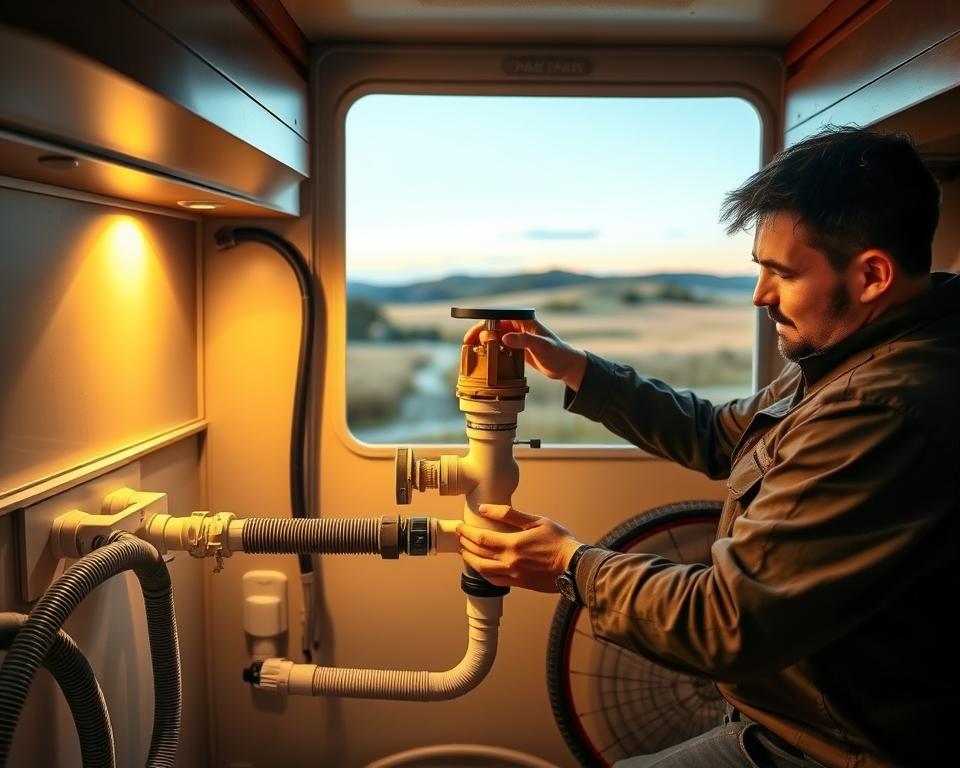Fine-Tune Your Motorhome’s Water System with a Pressure Vessel
Have you thought about the impact of an RV pressure tank on your camping ventures? On the road, your RV’s plumbing system becomes essential for daily activities like bathing and dishwashing. Optimizing this system ensures a consistent and dependable water flow, vital on the road. Let’s explore how an RV pressure tank can boost your onboard water system – RV tank pumping service near me, improving comfort during your adventures.
Summary Highlights
- A camper pressure tank boosts flow on the move.
- Dependable pressure matters for routine use.
- Fine-tuning plumbing enhances your outdoor stay.
- Pressure tanks help maintain consistent water pressure.
- Better flow aids all plumbing operations.
Why a Dependable RV Water System Matters
Consistent plumbing is key to enjoyable RV trips. It ensures everyday activities such as showering, washing dishes, and using the toilet are hassle-free. Challenges such as low water pressure can disrupt these activities, highlighting the necessity of proper water flow in your RV.
Low water pressure can stem from multiple problems. Common culprits include leaks, blockages, and low supply. Not only do these problems disrupt convenience, but they can also lead to bigger problems without timely intervention. Thus, consistent maintenance is crucial for a well-functioning RV plumbing system.
Important aspects of maintaining a robust RV water system include:
- Inspecting all fittings and lines for drips
- Maintaining clear filter elements
- Using a pressure limiter to prevent spikes
Adhering to these tips improves overall plumbing performance. It makes the camping experience comfortable.

What is an RV Pressure Tank?
An RV pressure tank plays a crucial role in a recreational vehicle’s water system. It ensures water pressure remains stable and consistent. This component holds and balances water, making it available even when demand peaks. It prevents the inconvenience caused by pressure drops.
The design of an RV water pressure tank often incorporates a bladder or diaphragm. This mechanism separates water from air, allowing for rapid pressurization. Recognizing the function of a camper pressure tank works empowers RV owners to manage their plumbing. A quality motorhome pressure tank boosts water delivery’s reliability and efficiency.
The Way a Pressure Tank Improves Water Delivery
The pressure tank ensures steady delivery. It prevents interruptions when multiple water sources are used at once. When faucets, showers, and toilets operate together, a pressure tank maintains uniform pressure.
This tank reduces pump cycling, leading to higher efficiency. It stores pressurized air, pushing water through the system. This results in the water pump runs fewer cycles. The result? Saved energy and an extended water pump life.
With pressure tanks, campers benefit from steady delivery, enhancing their experience. Consistent showers and efficient dishwashing become the norm. Knowing how a pressure tank works empowers users to avoid the hassle of varying water pressure.
| Characteristic | Advantage |
|---|---|
| Uniform Flow | Provides reliable delivery for daily tasks |
| Less Pump Cycling | Decreases wear on your pump |
| Instant Flow | Speeds up usage at any tap |
| Easy Installation | Makes retrofits straightforward |
Advantages of a Camper Pressure Tank
Adding a pressure vessel delivers multiple benefits. It leads to consistent water pressure, improving everyday chores. The absence of sudden water flow drops allows for fluid operation.
It also eases strain on the pump. By maintaining steady pressure, the tank extends the pump’s lifespan and cuts down on repair needs. This results in significant maintenance cost savings and less inconvenience over time.
Better water usage is another benefit. It helps avoid issues such as drips and bursts. These tanks boost plumbing system reliability, ensuring smooth journeys. With proper setup and maintenance, they bring assurance and comfort.
Picking the Perfect Camper Pressure Vessel
Choosing the correct RV pressure tank requires thought on many aspects to match your RV water system’s needs. Start by evaluating size. RV pressure tanks vary in size; knowing how much water you use will help choose appropriately.
Material choice affects lifespan. Tanks made of stainless steel or polyethylene last longer and resist corrosion. It’s crucial to select a tank that handles road vibrations and varying climates.
Bladder designs excel when considering options. They smooth out surges and protect pipes. Checking model specifications ensures compatibility with your system.
Getting advice from RV experts is beneficial. They ensure the tank works well with your RV’s plumbing, so you pick a tank that delivers satisfaction and efficiency.
Step-by-Step Pressure Tank Installation
Fitting a tank transforms your plumbing performance. It’s important to pay close attention and know RV plumbing basics. Start by choosing an accessible location for future maintenance.
Then, securely attach the inlet and outlet pipes. Ensure all joints are sealed. A key part is verifying the air pressure inside the bladder, which is critical for peak efficiency.
If you’re not confident in your installation skills, seek professional help, like those at All in Sanitation. Their expertise guarantees proper fitting, boosting your system’s delivery and longevity. Always adhere to manufacturer guidelines for long-term performance.
| Steps for Installation | Details |
|---|---|
| Select Location | Pick a convenient spot with easy access |
| Connecting Pipes | Tighten fittings properly |
| Verify Precharge | Match manufacturer specs for best performance |
| Follow Recommendations | Stick to install instructions exactly |
| Consult Experts | Ensure proper setup |
How to Care for Your Pressure Tank
To maximize lifespan, maintain regularly. Regular checks for leaks are essential to prevent water waste and ensure air pressure settings are correct. Additionally, inspect the water filter frequently.
Cleaning the filter is vital to avoid blockages and maintain smooth flow. An annual review is advisable to assess the tank’s performance and the associated plumbing. Documenting maintenance makes tracking easier.
Well-maintained tanks deliver steady flow, making every trip more enjoyable.
| Task | How Often | Description |
|---|---|---|
| Check for Leaks | Monthly | Inspect connections and seams for water seepage |
| Precharge Inspection | Monthly | Use a gauge |
| Filter Maintenance | Every 3 Months | Keep pathways clear |
| Yearly Service | Annually | Assess tank and plumbing health |
Maximizing Water Pressure with Additional Strategies
Smart habits raise your system’s efficiency. A water pressure regulator is key, as it maintains constant delivery and prevents damage from pressure spikes.
Avoid running multiple outlets at once. Prioritize needs, for example, don’t run shower and dishwasher together.
Quick showers help stabilize flow. This conserves water and stabilizes pressure, improving overall performance.
Keeping the water filter clean is crucial. A clogged filter restricts flow and undermines pressure. Regular maintenance ensures optimal performance.
Inspect the bypass valve often. A working bypass enhances performance, boosting the camper’s water system.
| Tip | Description | Impact on Water Pressure |
|---|---|---|
| Water Pressure Regulator | Prevent spikes | Protects plumbing, ensures uniform flow |
| Stagger Usage | Avoid simultaneous outlets | Improves pressure for prioritized needs |
| Shorter Showers | Keep showers brief | Conserves water, maintains flow |
| Filter Flushing | Clean or replace regularly | Prevents clogs |
| Check Bypass Valve | Test the bypass valve | Supports smooth flow |
In Closing
Understanding pressure tank benefits transforms your watering experience. It ensures a reliable supply and solid pressure, improving your road experiences. This dependability turns camping into comfortable, enjoyable adventures.
For optimal benefits, it’s essential to correctly install and maintain your pressure tank. Routine checks prevent flow hiccups. Adopting best practices keeps delivery steady.
Applying these tips guarantees worry-free water use. You can relish your time outdoors without concerns over water quality or supply. Enjoy your journeys with peace of mind!


